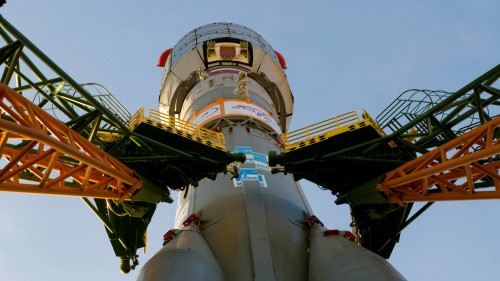
Tuesday, June 25 saw the launch of the first four satellites in a novel telecommunications network aimed at improving high-speed Internet access and mobile phone connectivity to vast numbers of people in developing parts of the world. The quartet of spacecraft, owned by the O3b company headquartered on the UK island of Jersey, was lofted into medium-Earth orbit by a Russian Soyuz rocket from the European-run Guiana Space Center near Kourou, French Guiana, on the northeast coast of South America.
Liftoff took place at 4:27 local time (3:27 EDT), a day later than originally scheduled due to unfavorable weather over the jungle location. The Fregat upper stage of the 151-foot-tall, three-stage vehicle was deployed about nine minutes later and then took more than two hours and several burns to deliver its payload of four 1,543-pound satellites into their correct orbits about 5,000 miles above the equator.
This altitude is key to the design and effectiveness of the O3b constellation. Situated at less than a quarter of the distance from the Earth’s surface of comsats in traditional geostationary orbits (22,500 miles high), the new satellites will drastically cut the latency, or delay, in voice or data traffic which they relay from and to the ground. Customers can expect a round-trip signal transmission time of just over 100 milliseconds—a sixth of that when messages are routed via geostationary platforms.
Other fleets of communications satellites, such as those owned by Iridium and Globalstar, work in low-Earth orbits, resulting in even lower signal delays, but are aimed specifically at supporting mobile communications and telephony markets, not broadband Internet.
The O3b satellites circle around the Earth above the equator and can support communications with points on the ground up to latitude 45 degrees north and south. They work in the Ka microwave band, each supporting 10 beams with a maximum capacity of 1.2 gigabits per second. The primary goal of O3b—the name stands for “other three billion”—is to bring high-performance Internet connectivity to places on the planet that are presently cut off from the global optical fiber infrastructure. Residents of the tiny island nation of the Cook Islands, in the South Pacific, will be among the first beneficiaries of the new service when commercial operations begin in about six months’ time, following the launch of four more identical satellites by a Soyuz-Fregat rocket in September.
A further four satellites are scheduled to go up next year, with the intention eventually to have as many as 20 in service at any one time. The constellation is designed to be highly scalable so that, if commercially successful, O3b can continue placing satellites in the same equatorial arc and gradually ramping up its capacity while driving costs down.
Founded in 2007, O3b has raised over $1 billion in capital to date and is backed by a number of major technology and financial partners, including Google, SES (one of the big players in the traditional satcom market), and HSBC.
Want to keep up-to-date with all things space? Be sure to “Like” AmericaSpace on Facebook and follow us on Twitter: @AmericaSpace



